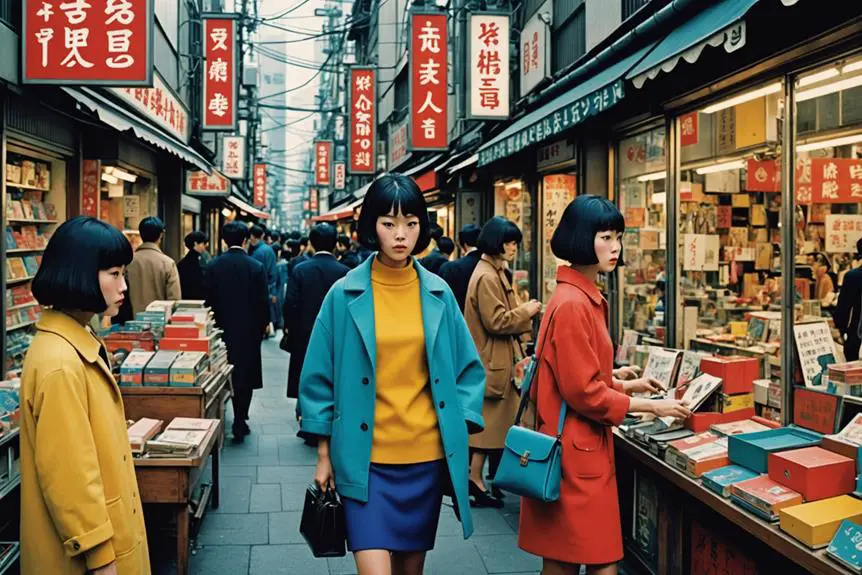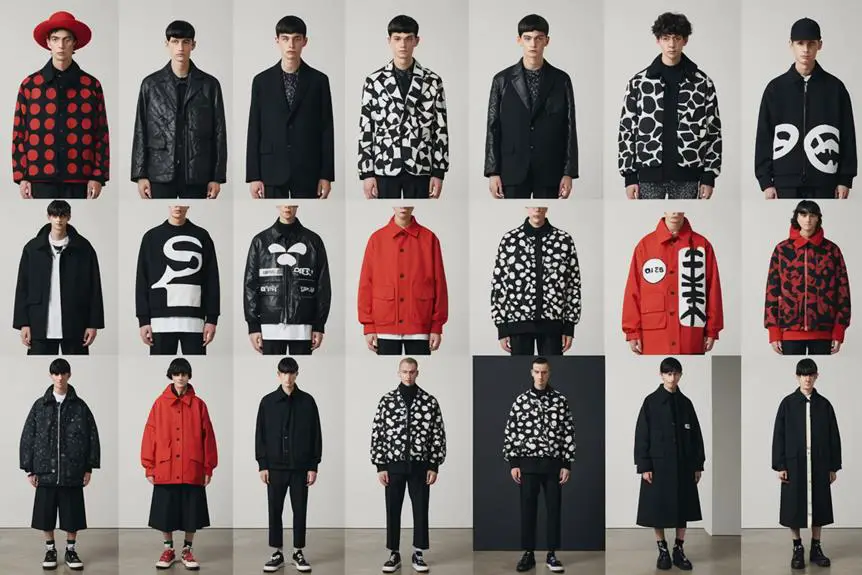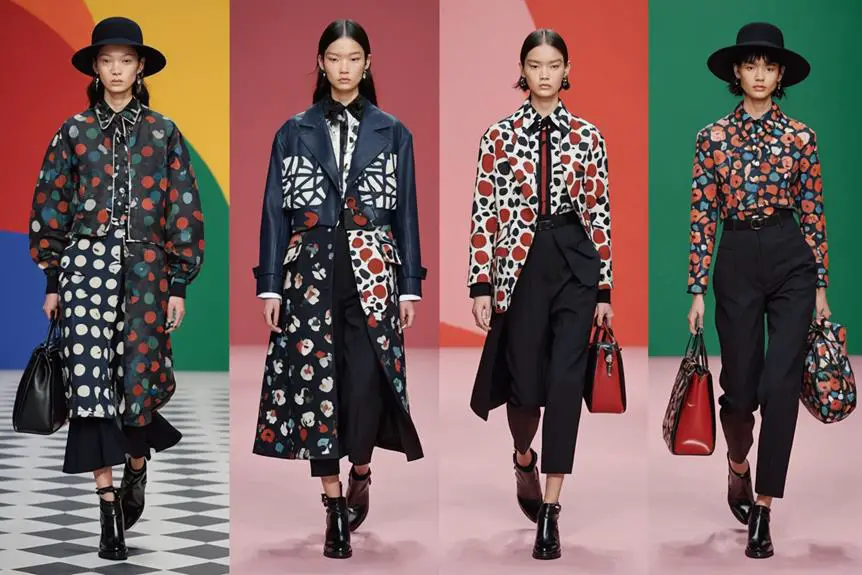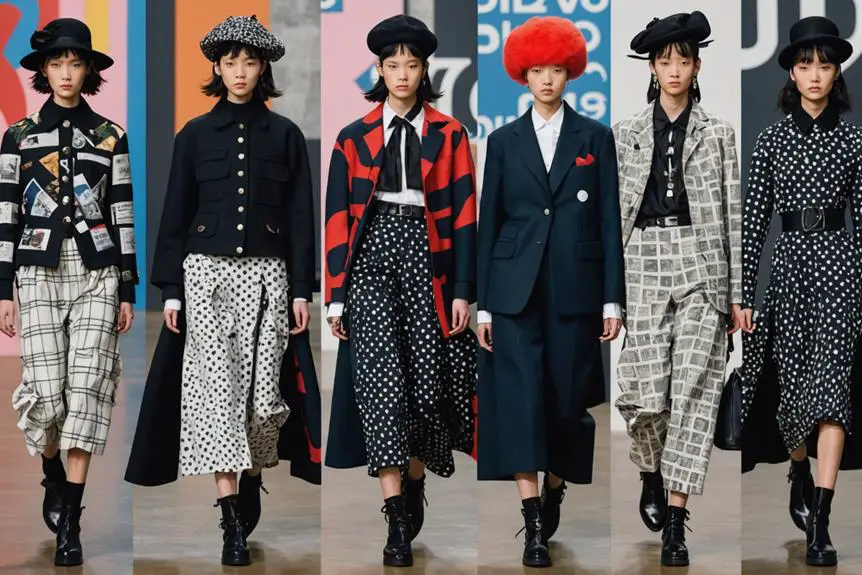Comme des Garçons, established by Rei Kawakubo in the late 1960s, revolutionized the fashion industry by challenging conventional norms with its avant-garde approach. The brand made a significant impact by debuting an all-black collection at Paris Fashion Week in 1981, which helped to create a distinct identity and propelled Japanese streetwear into the global spotlight. Over the years, a variety of sub-labels emerged, each embracing innovative design concepts. Collaborations with major brands like Nike and Converse further enhanced its cultural relevance and reach. Despite facing controversies throughout its journey, Comme des Garçons' influence on fashion discourse remains profound. As you delve deeper, you'll uncover the intricate layers of its evolution and the lasting impact it has had within the industry.
Founding and Early Years

In the late 1960s, a significant shift in the fashion landscape emerged with the founding of Comme des Garçons by Rei Kawakubo in Tokyo, Japan. This avant-garde fashion label marked a departure from conventional aesthetics, emphasizing innovation over tradition. By 1973, the brand officially established KK Comme des Garçons as a womenswear label, which solidified its presence in an industry often dominated by European designers. The brand's unique approach to design is reflected in its brand overview and history, showcasing a commitment to pushing boundaries and redefining fashion norms.
Kawakubo's creations were characterized by innovative designs that challenged normative ideas of beauty and femininity. The brand gained international recognition after debuting at Paris Fashion Week in 1981, where its all-black collection garnered mixed reviews. Critics described the collection using phrases like "Hiroshima chic," reflecting the stark, deconstructed silhouettes that became a hallmark of Kawakubo's vision.
Throughout the late 1970s, Comme des Garçons gained considerable prominence in Japan, setting the stage for the introduction of its menswear line in 1978. This expansion further solidified the brand's identity as a Japanese brand that dared to question and redefine the parameters of fashion, ultimately influencing countless designers in the decades to follow.
Evolution of Sub-Labels
The evolution of sub-labels under Comme des Garçons reflects the brand's commitment to innovation and its ability to adapt to changing fashion landscapes. Starting with Comme des Garçons Homme in 1978, the brand introduced a menswear collection that emphasized easy-to-wear pieces, challenging conventional styles. This initial foray laid the groundwork for subsequent lines that would push boundaries even further.
In 1984, Comme des Garçons Homme Plus emerged, showcasing avant-garde designs that prioritized deconstruction and innovative tailoring. This line appealed to those seeking a more experimental approach to menswear. Following this, Comme des Garçons Homme Deux launched in 1987, merging preppy aesthetics with traditional Japanese craftsmanship, providing a distinct perspective on menswear.
The introduction of Comme des Garçons SHIRT in 1988 revitalized casual wear, presenting staple items with a rebellious twist, indicative of Rei Kawakubo's innovative spirit. Finally, Play Comme des Garçons debuted in 2002, targeting a younger audience with its iconic heart logo and focus on accessible streetwear essentials. Collectively, these sub-labels illustrate Comme des Garçons' dynamic evolution, consistently reshaping the menswear landscape while remaining rooted in avant-garde principles.
Key Collaborations and Partnerships

Comme des Garçons' innovative spirit extends beyond its sub-labels through strategic collaborations and partnerships that redefine fashion boundaries. The brand's ability to fuse high fashion with streetwear is evident in its partnerships with influential names like Nike and Converse. In 2012, the Dover Street Market X Nike Air Force 1 sneakers emerged, signaling a new era for sneaker design that appealed to both streetwear enthusiasts and high fashion aficionados.
Similarly, the collaboration with Converse introduced a distinctive multi-heart motif on Chuck Taylor sneakers, which became a cultural staple in casual fashion. In 2021, Comme des Garçons Homme Plus further showcased its innovative edge by reimagining the Nike Air Carnivore, reflecting a commitment to evolving sneaker aesthetics.
Moreover, collaborations with streetwear giant Supreme have produced limited-edition pieces that blend the two worlds seamlessly, while ties with luxury brands like Louis Vuitton highlight the brand's expansive influence.
| Brand | Year |
|---|---|
| Nike | 2012 |
| Converse | 2015 |
| Supreme | Ongoing |
These collaborations illustrate how Comme des Garçons continues to challenge and redefine contemporary fashion.
Cultural Impact and Controversies
Significant cultural shifts often stem from the bold choices made by fashion houses, and Comme des Garçons has played a pivotal role in shaping urban fashion. By popularizing black clothing and embracing an avant-garde ethos, the brand challenged traditional aesthetics, particularly during the punk era of the 1980s. However, this influence hasn't come without its controversies. The 1995 "Sleep" collection, which controversially referenced Auschwitz, faced backlash from the World Jewish Congress, highlighting the sensitive nature of cultural representation in fashion.
In more recent years, concerns over cultural appropriation emerged, particularly with the 2015 Spring/Summer collection featuring guarachero boots and the 2020 menswear show that included cornrowed wigs on non-Black models. Such choices prompted apologies, showcasing the ongoing dialogue surrounding cultural sensitivity in the fashion industry. Comme des Garçons' fashion shows often push boundaries, provoking discussions on social issues and ethics. Rei Kawakubo's willingness to grapple with complex topics guarantees that the brand remains a focal point for conversations about the intersection of fashion and culture. Ultimately, Comme des Garçons exemplifies how the fashion industry can both inspire and challenge societal norms.
Fragrance and Lifestyle Expansion

Established in 1994, the Comme des Garçons perfume line has carved out a unique niche in the fragrance market, reflecting the brand's avant-garde ethos. Spearheaded by Rei Kawakubo, the line began with its eponymous fragrance, which showcased an experimental scent profile that defied conventional olfactory norms. This initial offering set a precedent for subsequent releases, emphasizing unique offerings that resonate culturally and creatively with consumers.
As the brand expanded into lifestyle products, the fragrance line became essential in broadening Comme des Garçons' reach beyond clothing. The incorporation of various scent compositions illustrates a commitment to innovation, appealing to a diverse demographic. Collaborations with artists and designers not only enhance the brand's narrative but also enrich the sensory experience, reinforcing its status as a leader in avant-garde fragrance.
The ongoing cultural resonance of Comme des Garçons fragrances lies in their ability to challenge traditional boundaries, ensuring that each scent remains a work of art. By embracing these experimental approaches, the brand continues to attract enthusiasts who seek distinctiveness in their personal and home fragrances, thereby solidifying its place in the competitive fragrance industry.
Retail Innovations and Concepts
Retail innovations at Comme des Garçons reflect a bold reimagining of the shopping experience, transforming how consumers interact with fashion. The establishment of Dover Street Market in 2004 epitomizes this approach, offering a curated selection of avant-garde brands alongside Comme des Garçons collections, creating a sense of "beautiful chaos." This multi-label department store invites exploration and engagement, challenging conventional retail norms.
In 2004, the launch of Guerrilla Stores marked another innovative stride, utilizing low-budget interiors to deliver unique, temporary retail experiences in cities like Berlin and Reykjavik. These stores reemerged in 2021, continuing to captivate diverse audiences. The Under The Ground Store in Hong Kong, opened in 2009, further showcased an unconventional layout that emphasized Comme des Garçons' commitment to innovative retail concepts.
Additionally, the brand's flagship stores in Tokyo and Paris focus on experiential retail, providing immersive shopping experiences that reflect its avant-garde identity. Collaborations with artists enrich these environments, merging art with retail and fostering a unique atmosphere. Collectively, these initiatives underscore how Comme des Garçons continually challenges and redefines the boundaries of fashion retail.
Recent Developments and Trends

Comme des Garçons continues to push the boundaries of fashion retail, evidenced by its recent developments and trends that resonate with both the brand's avant-garde ethos and the evolving consumer landscape. The reintroduction of Guerrilla stores in 2021 exemplifies this commitment, creating temporary retail experiences that engage you in unique shopping environments, reinforcing the brand's innovative spirit.
In 2022, Comme des Garçons made waves with collaborations such as the Converse x Comme des Garçons Play One Star and the CdG x Nike Air Max 91, showcasing cutting-edge sneaker designs that cater to the footwear market's ever-changing dynamics. The partnership with Salomon on platform sneakers reflects the growing trend towards hybrid styles, blending function and fashion effectively.
Moreover, Comme des Garçons is expanding its reach through direct-to-consumer labels like CDG, which launched in 2018, targeting younger demographics with logo-centric styles. The brand's 2023 collaboration with BAPE further cements its trendsetting role in contemporary fashion. By embracing these developments, Comme des Garçons not only stays relevant but also leads the charge in shaping the future of fashion retail.
Frequently Asked Questions
What Is the Story Behind Comme Des Garçons?
Comme des Garçons embodies a revolutionary approach to fashion, challenging norms through avant-garde designs. Its unique aesthetic provokes thought, encouraging you to reconsider conventional beauty while celebrating individuality and cultural expression in contemporary clothing.
What Is the Comme Des Garcon Controversy?
The Comme des Garçons controversy revolves around cultural appropriation and insensitivity. You'll find critics questioning the brand's provocative designs, which often challenge aesthetics yet provoke discussions on the balance between artistic expression and cultural respect.
What Does "The Heart on Comme Des Garçons" Mean?
The heart on Comme des Garçons symbolizes a playful approach to fashion. This iconic motif blends simplicity with whimsy, reflecting the brand's mission to make high fashion accessible while maintaining a sense of humor and charm.
What Does Comme De Garcon Mean in English?
"Comme des Garçons" translates to "like boys" in English. This phrase encapsulates a playful, avant-garde ethos, challenging traditional gender norms and representing a fluid interpretation of style that resonates with contemporary fashion's evolving landscape.





The articles you write help me a lot and I like the topic http://www.ifashionstyles.com
May I request that you elaborate on that? http://www.ifashionstyles.com Your posts have been extremely helpful to me. Thank you!
May I request more information on the subject? http://www.hairstylesvip.com All of your articles are extremely useful to me. Thank you!
You helped me a lot by posting this article and I love what I’m learning. http://www.kayswell.com
One thing I’ve noticed is that there are plenty of misconceptions regarding the banks intentions if talking about foreclosed. One myth in particular is the fact that the bank wishes to have your house. The lending company wants your hard earned cash, not your home. They want the amount of money they lent you together with interest. Preventing the bank will simply draw some sort of foreclosed realization. Thanks for your publication.
Undeniably believe that which you said. Your favourite reason seemed to be on the web the easiest factor to be aware of. I say to you, I certainly get irked even as folks think about concerns that they just do not realize about. You managed to hit the nail upon the highest as neatly as outlined out the whole thing with no need side effect , other people could take a signal. Will probably be back to get more. Thank you
Great info and right to the point. I don’t know if this is truly the best place to ask but do you people have any ideea where to employ some professional writers? Thanks 🙂
May I request that you elaborate on that? http://www.kayswell.com Your posts have been extremely helpful to me. Thank you!
May I have information on the topic of your article? http://www.kayswell.com
Vovan Casino — ????????????, ??? ????? ????????? ?????????
?????????????. ?????? ????? ???????????? ??????? ??????? ???????????, ??????? ???????? ?? ????? ????, ??????? ? ????????? ???????.
?? ?????? ???? — Vovan casino
???? ??????????? ???? ??????????? — ? ???? ?????? ????????? ???? ??????, ??? ??????
?????????.
?????? ????????? ?????, ?? ???????? ?? ???????, ??? ????????? ????????? ??????????? ? ??????? ???????.
Vovan Casino ????????? ? ????? ???????:
?????? ??????????? ???????, ????????? ???????? ??????, ? ??????? ????????
??? ????????.
???????? ? ?????? ??? ???????? ? ??????????
???????
????????????, ??? ??????
????? ????? ???????????
????????? 24/7 — ?????? ?????
???? ?? ????? ??????-?????? ? ??????? ?????????? ? ?????? ????????????? — Vovan Casino ?????? ????? ??????? https://privetka.ru/
Thank you for being of assistance to me. I really loved this article. http://www.kayswell.com
May I request more information on the subject? http://www.kayswell.com All of your articles are extremely useful to me. Thank you!
Vovan Casino — ????????, ??? ????? ?????????? ???????????.
????? ??? ???????? ?? ?????????:
?? ?????????? ????????? ?????????? ?? ????????????? ??????
???????. ???????????? ???????????? — Vovan ?????????? ????? — ? ?????? ??? ???? ???,
??? ????? ?????????? ???????????? ??????.
??????? ??????? Vovan Casino ??????????: ?? ??????????? ?????? ?? ????????? ??????? ? ?????? ????????.
???????, ??????? ?? ??? ????? — ???? ???????? ????? ????????????.
?????? ? ???????? ???? ???? ?????? ????
????? ??? ?????? — ?? ?????????
??? ????????
?????? ????????? ???????? ??? ????????
????? ??? ????????? ????? — ?????? ??????????? ??????? ? ????? ?????? https://roslodka.ru/
Vovan Casino — ????????, ??? ????? ?????????? ???????????.
????? ??? ???????? ?? ?????????:
?? ?????????? ????????? ?????????? ?? ????????????? ?????? ???????.
???????????? ???????????? — Vovan ?????????? ????? — ? ??????
??? ???? ???, ??? ????? ?????????? ???????????? ??????.
??????? ??????? Vovan Casino ??????????:
?? ??????????? ?????? ?? ????????? ??????? ? ?????? ????????.
???????, ??????? ?? ??? ????? — ???? ???????? ?????
????????????.
?????? ? ???????? ???? ???? ?????? ????
????? ??? ?????? — ?? ?????????
??? ????????
?????? ????????? ???????? ???
????????
????? ??? ????????? ????? — ?????? ??????????? ??????? ? ????? ?????? https://roslodka.ru/
I read this paragraph fully on the topic of the resemblance of most
recent and preceding technologies, it’s amazing article. https://gizbo-777-jackpot.top/
I read this paragraph fully on the topic of the resemblance of most recent and
preceding technologies, it’s amazing article. https://gizbo-777-jackpot.top/
Hello, i think that i saw you visited my site thus i came to “return the favor”.I’m attempting to find things to improve my web site!I suppose its ok to use
some of your ideas!! https://vovan-questzone.top/
Hello, i think that i saw you visited my site thus i came to “return the favor”.I’m attempting to find things to improve my web site!I
suppose its ok to use some of your ideas!! https://vovan-questzone.top/
Can I simply say what a relief to find a person that really knows what they’re talking about on the net.
You certainly know how to bring an issue to light and make it
important. More people really need to check this out and understand this side
of the story. I was surprised that you are not more popular given that
you definitely have the gift. https://r7-jackpot.buzz/
An impressive share! I’ve just forwarded this
onto a colleague who was conducting a little research on this.
And he actually bought me breakfast simply because I
discovered it for him… lol. So allow me to reword this….
Thanks for the meal!! But yeah, thanks for spending the
time to discuss this subject here on your blog. https://vovan-champion.top/
An impressive share! I’ve just forwarded this onto a colleague who was conducting a little research on this.
And he actually bought me breakfast simply because I discovered it
for him… lol. So allow me to reword this…. Thanks for the meal!!
But yeah, thanks for spending the time to discuss this subject here on your blog. https://vovan-champion.top/
Vovan Casino — ????????????, ??? ????? ????????????? ? ????????? ????????.
?????? ????? ???????????? ??????? ??????? ???????????, ???????
???????????? ?????, ????????? ???? ? ????? ??????.
?? ?????? ???? — Vovan ???? ?? ???????????? —
? ???? ?????? ????????? ???? ??????,
??? ?????? ?????????.
?????????? ????? ?????????? ? ????????,
??? ????????? ??????????????? ??
???? ??? ??????????? ???????. Vovan Casino
????????? ? ????? ???????: ?????? ??????????? ???????, ?????????
???????? ??????, ? ??????? ???????? ??? ????????.
?????? ?????????????? ??????? — ???????? ??????
?????????? ??????? ? ?????????? ???????
????????? 24/7 — ?????? ?????
???? ?? ????? ??????-?????? ? ??????? ?????????? ? ?????? ????????????? — Vovan Casino ?????? ????? ??????? https://privetka.ru/
I’m now not positive where you’re getting your info, however good topic.
I must spend some time studying more or understanding more.
Thank you for great information I was searching for
this info for my mission. https://gizbogamez.buzz/
I’m now not positive where you’re getting your info,
however good topic. I must spend some time studying more or understanding more.
Thank you for great information I was searching for this info for my mission. https://gizbogamez.buzz/
wonderful issues altogether, you just gained a emblem new reader.
What could you recommend in regards to your put up that you simply made a few days in the past?
Any positive? https://vovangames-spins.top/
wonderful issues altogether, you just gained
a emblem new reader. What could you recommend in regards to your put
up that you simply made a few days in the
past? Any positive? https://vovangames-spins.top/
Vovan Casino — ?????, ??? ????? ???? ??????.
????? ?????? ???? — ??? ?
????????????. ?????? ? ????????????
????? ????? — ? ?????? ? ???????!
????????? ??? ???????. ?????? ????? — ??? ?????? ? ????? ??????????? ? ??????.
??????? ??? ????????? ????????
?????????? ??????? ??? ????????
????? ? ????? ????? ? ? ????? ?????
Vovan Casino — ?????? ??? ????????? ????????? ???????????. https://vovangames-portal21.top/
Vovan Casino — ?????, ??? ????? ???? ??????.
????? ?????? ???? — ??? ?
????????????. ?????? ? ????????????
????? ????? — ? ?????? ? ???????!
????????? ??? ???????.
?????? ????? — ??? ?????? ? ????? ??????????? ? ??????.
??????? ??? ????????? ????????
?????????? ??????? ??? ????????
????? ? ????? ????? ? ? ????? ?????
Vovan Casino — ?????? ??? ????????? ?????????
???????????. https://vovangames-portal21.top/
?????? ???????? [url=http://www.samokleyushchayasya-plenka-1.ru]?????? ????????[/url] .
???????????? ?????? ?????? ? ??? [url=https://dizajnerskaya-mebel-1.ru/]???????????? ?????? ?????? ? ???[/url] .
Gizbo Casino — ?????? ??????. ??? ??????? ?????????:
????????? «?????» — ???. ??????
? ???? ???? — ?????? ?? ???????????? —
? ????? ???????.
??????? ?????????? ? ????????, ??????
— ?? ????. ???????? — ??? ??? ????
????? ???????.
??????? ? ???? ??????
??????? ??????????
?????? ? ???? ????
Gizbo — ??????? ???????, ???????? ??????????. https://gizbocasino-game88.top/
Gizbo Casino — ?????? ??????. ??? ??????? ?????????: ????????? «?????» —
???. ?????? ? ???? ???? — ?????? ?? ???????????? — ? ????? ???????.
??????? ?????????? ? ????????, ?????? — ?? ????.
???????? — ??? ??? ???? ????? ???????.
??????? ? ???? ??????
??????? ??????????
?????? ? ???? ????
Gizbo — ??????? ???????, ????????
??????????. https://gizbocasino-game88.top/
Vovan Casino — ????????, ??? ??????? ?????????? ? ???????.
????? ?????? ?????? ?????????? ?????
? ??????. ???????????? ????????? ???????????? ????????? —
?????? ????? ????.
?????? ???????? ???? ??
??????? ???????????. ?????? ??????? ????????? ?????? ??? ?????? ????????.
VIP-?????? ? ??????????
?????????? ?????? ?????? private banking
????????? 24/7 ? ????? ????????-???????
Vovan Casino — ??? ???? ??? ???????? ????. https://vovan-casino-bonus54x.top/
Vovan Casino — ????????, ??? ??????? ?????????? ? ???????.
????? ?????? ?????? ?????????? ????? ? ??????.
???????????? ????????? ???????????? ????????? — ?????? ????? ????.
?????? ???????? ???? ?? ??????? ???????????.
?????? ??????? ????????? ?????? ???
?????? ????????.
VIP-?????? ? ??????????
?????????? ?????? ?????? private banking
????????? 24/7 ? ????? ????????-???????
Vovan Casino — ??? ???? ??? ???????? ????. https://vovan-casino-bonus54x.top/
?????? ???????????? ???? [url=http://www.kondicioner-obninsk-1.ru]?????? ???????????? ????[/url] .
???????? ??????? [url=www.natyazhnye-potolki-lipeck-1.ru]www.natyazhnye-potolki-lipeck-1.ru[/url] .